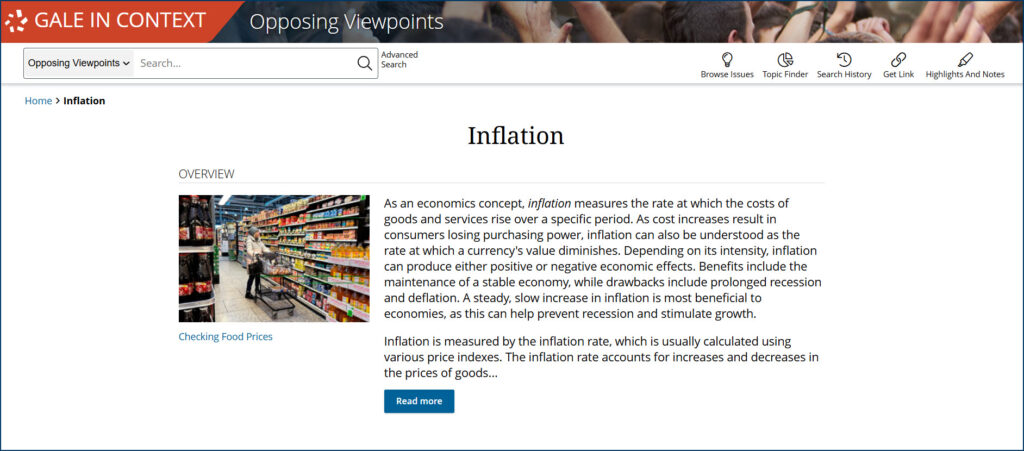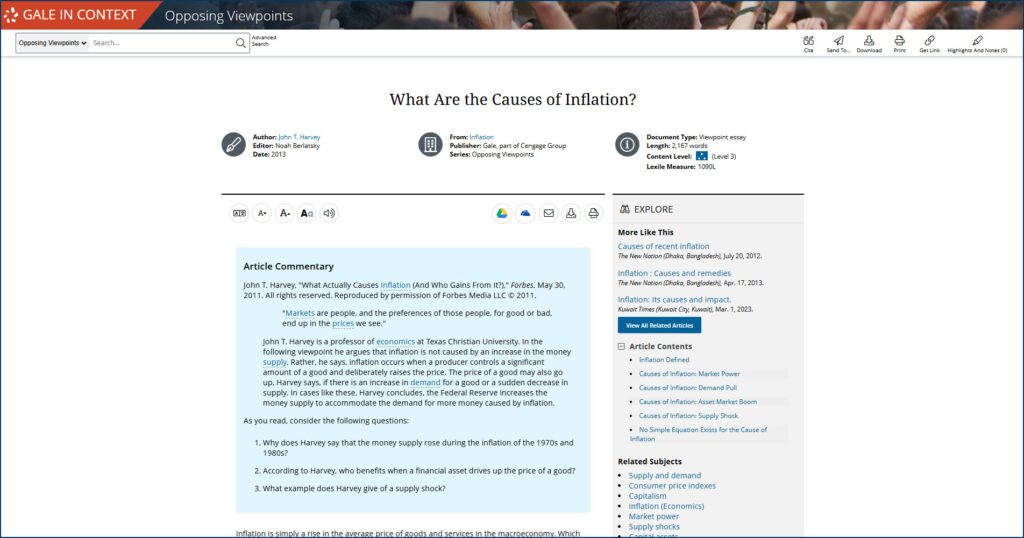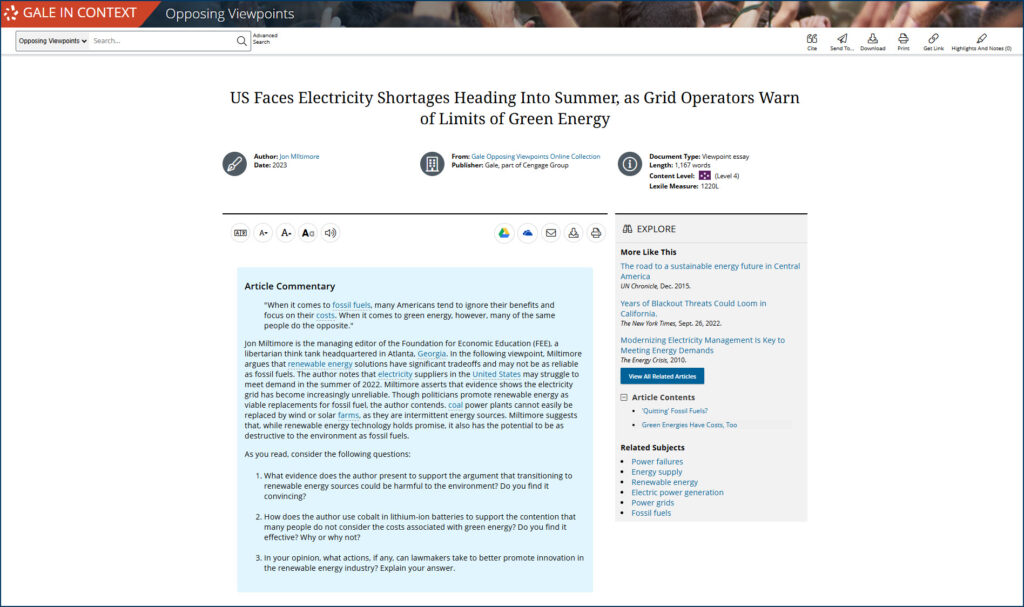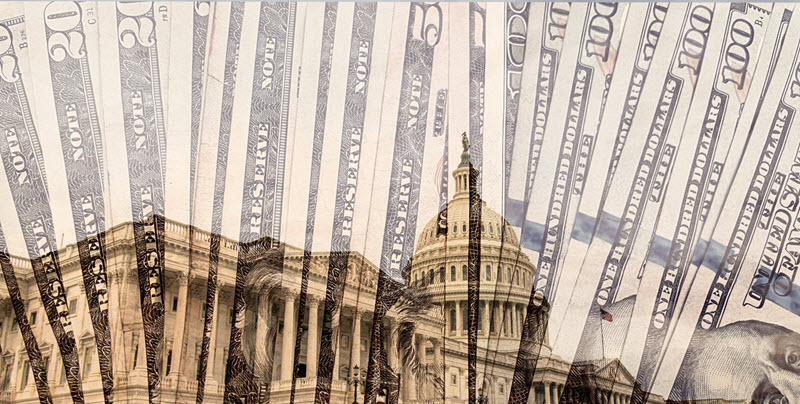| By Gale Staff |
Inflation has dominated national conversations since 2021, when the US inflation rate tripled from the pre-pandemic rate of 2.3% to 7%.
Beneath these numbers lies a complex web of cause and consequence. A disruption in oil production can send energy prices soaring, while supply chain bottlenecks can drive up the cost of everyday goods.
Even with inflation’s recent drop to 2.4% as of September 2024, headlines about President Trump’s tariff proposals highlight market volatility. Household budgets bear the brunt of costs when trade is used as a bargaining chip. Those additional import fees trickle down to consumers, increasing the price of goods like automobiles and gasoline.
The Inflation topic page available through Gale In Context: Opposing Viewpoints equips educators with the tools to bring these complexities into the classroom, offering resources that illuminate the causes and consequences of inflation from diverse perspectives.

Let’s take a look at some of the key factors behind inflation, so you can open your classroom to debate on how to best address them.
What Is Inflation? A Primer for Classroom Discussion
To tackle a concept as complex as inflation, start with the essentials on the Introduction to Inflation topic overview available through Gale In Context: Opposing Viewpoints.
At its simplest, inflation measures the gradual rise in prices over time. For example, a pound of bread cost $0.57 in August 1986, but $1.97 in June 2024. These prices are tracked by the Consumer Price Index, published by the Bureau of Labor Statistics. This metric calculates the average price changes of a fixed set of everyday purchases made by households, like food, clothing, and transportation.
Factors Behind Inflation
Many factors influence inflation. Before digging further into the debates on how to address them, we recommend using the Gale In Context: Opposing Viewpoints search feature to access resources like “What Are the Causes of Inflation?” for an overview of these contributing factors. Learners may also benefit from reviewing other topics like supply and demand.

Global Events and Supply Chain Disruptions
The global scale of our modern supply chain means that products see dozens of touchpoints before they reach store shelves. When there’s a disruption in the line, everyone feels the impact—an issue that became even more evident during the COVID-19 pandemic. Factory shutdowns in Asia combined to create widespread shortages in everything from medical supplies to consumer electronics.
Real-World Context
Modern vehicles can have anywhere from 1,000 to 3,000 semiconductor chips. Because most of these chips are manufactured in Asia, supply chain disruptions there can impact the availability of both domestic and imported vehicles.
That’s exactly what happened when worldwide car production fell by 11.3 million units due to a global semiconductor shortage. At the same time, high demand created bottlenecks at shipping ports, further exacerbating the issue and raising the average cost to ship a container from Asia to the US West Coast from $2,000 to more than $20,000.
This ripple effect caused the price of new cars to increase by 11.7% and used cars to increase by 37.2%, both far outpacing the overall inflation rate of 7%.
The Debate: Should Countries Reshore Manufacturing?
Some policymakers and businesses have championed reshoring—shifting production back to domestic facilities—to mitigate reliance on international supply chains.
Supporters’ Perspective: Reshoring advocates argue that the US reliance on international supplies leaves the nation vulnerable to disruptions caused by trade disputes, geopolitical conflicts, and natural disasters. If we rebuilt key segments of the supply chain domestically, industries producing essential goods would face fewer risks and avoid shortages to the extent seen with COVID-19. There are also potential economic benefits. Production localization would not only secure the supply chain and create thousands of manufacturing jobs, further stimulating the economy.
Opponents’ Perspective: Critics caution that the shift could create financial challenges for businesses and consumers. Due to stricter labor regulations and compliance requirements, domestic manufacturing often costs more. Opponents also argue that reshoring could limit innovation and competition. Global supply chains require collaboration between companies and countries, while local production would isolate industries from these opportunities, leading to potential stagnation. Additionally, transitioning production back to domestic facilities would require large-scale infrastructure investments—a cost only major corporations and governments could shoulder.
Global Volatility and National Energy Insecurities
Few factors drive inflation as quickly or broadly as disruptions in energy markets. To some degree, every industry relies on oil, gas, or electricity to operate, so when energy prices rise, businesses incur higher costs.
These rising costs don’t stay confined to one business or sector—they cascade throughout the economy. For example, a shipping company might charge higher fees to transport goods, increasing retailers’ costs. These retailers then raise prices for consumers to maintain their profit margins. This cumulative effect amplifies inflation, as higher energy prices make everyday goods and services more expensive for households.
Real-World Context
The ongoing Russia-Ukraine war, which began in 2022, has demonstrated the fragility of this system. As tensions flared, Russian energy supplies stopped flowing, leading to a surge in energy prices. In the United States, gas prices reached a record-high average just over $5 per gallon in June 2022, straining household budgets and increasing transportation costs.
The impact in Europe was even more severe. Germany, which relied on Russia for nearly 65% of its natural gas supply, was particularly vulnerable to price volatility. The government took emergency measures, rationing energy by reducing hot water, heating, and electricity use.
You can engage students more actively in identifying potential vulnerabilities by asking them to use Gale In Context: Opposing Viewpoints to research a product’s supply chain, focusing on the points where energy is required. How do rising energy costs at these stages impact production’s efficiency and affordability?
The Debate: Is Renewable Energy the Solution to Energy Volatility?
Currently, 22.5% of America’s electricity comes from renewable energy. As energy prices fluctuate and geopolitical conflicts continue, however, there are serious discussions about how to increase this share.
Supporters’ Perspective: Supporters argue that transitioning to renewable energy would reduce the United States’ reliance on foreign fossil fuels, which could, in turn, lessen our exposure to geopolitical instability. Additionally, transitioning to hydropower, solar, and wind would help lower emissions and provide economic benefits at home. Eliminating some of the factors behind fluctuating fuel prices can lower energy costs over time, while investments in renewable infrastructure stimulate job creation. For example, renewable energy jobs grew worldwide from 12.7 million in 2021 to 13.7 million in 2022, a year-over-year increase of 7.87%.
Opponents’ Perspective: Though critics acknowledge renewable energy’s potential, they caution against turning to it as a one-for-one replacement for traditional energy sources. Building infrastructure requires an upfront investment that governments and taxpayers must fund. Moreover, renewable energy systems depend heavily on weather conditions, leading to inconsistent output. If renewable energy sources cannot ramp up production to meet surging demand like natural gas plants can, this limitation calls into question the reliability of our energy grid.

Preparing Students for Tomorrow’s Economy Today
With Gale In Context: Opposing Viewpoints, students get exposure to a range of perspectives on inflation and other headline-grabbing topics, so they can examine their complexities and get a better grasp of their effect on daily life.
For teens, these discussions matter because the effects of inflation are already a reality. The Bureau of Labor Statistics reported that more than one in five high schoolers have part-time jobs, many of which pay entry-level wages. Of those, around 66% contribute to household budgets stretched thin by rising rents and utility bills.
The increasing cost of education adds to the pressure, forcing students to make difficult financial decisions about their futures. But while inflation can feel beyond their control, understanding how economic policies shape their lives can empower them to make informed choices as consumers and future voters.
Reach out today to talk with a Gale sales representative about how Opposing Viewpoints can support financial literacy education in your classroom.

